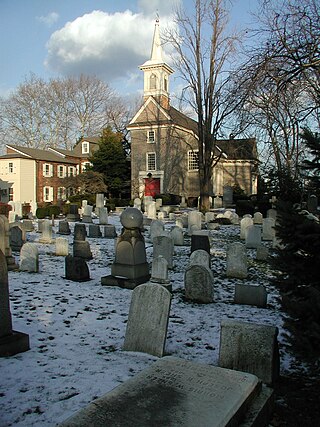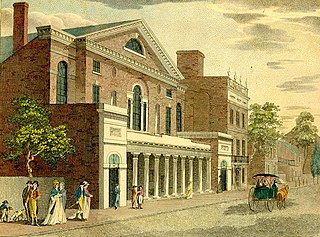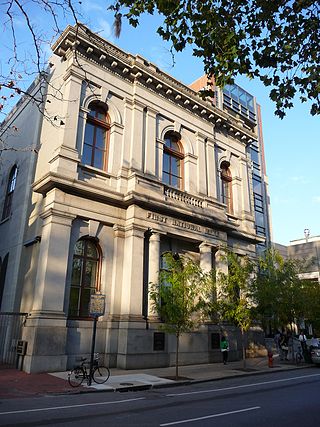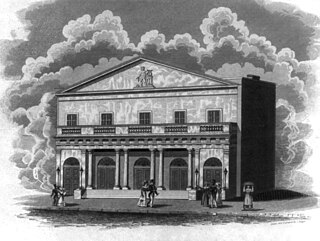Related Research Articles

The Philadelphia nativist riots were a series of riots that took place on May 6—8 and July 6—7, 1844, in Philadelphia, Pennsylvania, United States and the adjacent districts of Kensington and Southwark. The riots were a result of rising anti-Catholic sentiment at the growing population of Irish Catholic immigrants. The government brought in over a thousand militia—they confronted the nativist mobs and killed or wounded hundreds of anti-Catholic rioters.
The Old American Company was an American theatre company. It was the first fully professional theatre company to perform in North America. It also played a vital role in the theatre history of Jamaica. It was founded in 1752 and disbanded in 1805. It was known as the Hallam Company (1752–1758), the American Company (1758–1785) and the Old American Company (1785–1805). With a few temporary exceptions, the Company enjoyed a de facto monopoly of professional theatre in the United States until 1790.

South Street in Philadelphia, originally named Cedar Street in William Penn's original street grid, is an east–west street forming the southern border of Center City and the northern border for South Philadelphia in Pennsylvania, United States.

Walnut Street Theatre, founded in 1808 at 825 Walnut Street, on the corner of S. 9th Street in the Washington Square West neighborhood of Philadelphia, is the oldest operating theatre in the United States.

The Cradle of Liberty Council (#525) is a Boy Scouts of America council created in 1996 with the merger of the former Philadelphia Council and the former Valley Forge Council.

Queen Village is a residential neighborhood of Philadelphia, Pennsylvania, United States that lies along the eastern edge of the city in South Philadelphia. It shares boundaries with Society Hill to the north, Bella Vista to the west and Pennsport to the south. Street boundaries are the south side of Lombard Street to the north side of Washington Avenue, the Delaware River to 6th Street, encompassing two principal commercial corridors, South Street and Fabric Row on 4th Street.

Spring Garden College—founded in 1851 as the Spring Garden Institute—was an American private technical college in the Spring Garden section of Philadelphia, Pennsylvania. Its building at 523–25 North Broad Street (demolished) was designed by architect Stephen Decatur Button.

Walnut Street is located in Center City Philadelphia and extends to the Delaware River waterfront and West Philadelphia. Walnut Street has been characterized as "the city's premier shopping district" by The Philadelphia Inquirer.

The John Street United Methodist Church – also known as Old John Street Methodist Episcopal Church – located at 44 John Street between Nassau and William Streets in the Financial District of Manhattan, New York City was built in 1841 in the Georgian style, with the design attributed to William Hurry and/or Philip Embury. The congregation is the oldest Methodist congregation in North America, founded on October 12, 1766 as the Wesleyan Society in America.

Hedgerow Theatre is a theatre company based in Rose Valley, Pennsylvania, near Philadelphia, founded in 1923. It was "for many years the only true U. S. professional repertory theater." The building is a contributing structure in the Rose Valley Historic District listed on the National Register of Historic Places.
Lewis Hallam was an English-born actor and theatre director in the colonial United States.

Thomas Wignell was an English-born actor and theatre manager in the colonial United States.

The Chestnut Street Theatre in Philadelphia, Pennsylvania was the first theater in the United States built by entrepreneurs solely as a venue for paying audiences.

John Street Theatre, situated at 15–21 John Street, sometimes called "The Birthplace of American Theatre", was the first permanent theatre in the Financial District of Manhattan, New York. It opened on December 7, 1767, and was operated for several decades by the American Company. It closed on January 13, 1798.
The following is a timeline of the history of the city of Philadelphia, Pennsylvania.

First National Bank was a bank in Philadelphia. Chartered in 1863, it was the first national bank created under the banking reforms of the Civil War that began to define the modern U.S. banking system, and the first commercial bank to issue a federal banknote. It operated independently until 1955, when it was merged into the Bank of North America and Trust Company, which now is part of Wells Fargo.

John Hodgkinson was a well-known actor in the United States in the late 18th and early 19th century. He was born in England and came to the United States in 1792. William Dunlap and Hodgkinson managed the John Street Theatre together for a few years in the 1790s.
John Street is a street running north to south through the Financial District of Lower Manhattan in New York City. It is one of the oldest streets in the city. Long associated with maritime activity, the street ran along Burling Slip. The slip was filled in around 1840, and the street widened. Besides a wharf, warehouse, and chandlery, the city's first permanent theatre, and the first Methodist congregation in North America were located on John Street. It was also the site of a well-known pre-Revolutionary clash between the Sons of Liberty and British soldiers, pre-dating the Boston Massacre by six weeks.

The Arch Street Theatre, popularly referred to as The Arch, was one of three Philadelphia-based theaters for plays during the 19th century; the other two were the Walnut Street Theatre and the Chestnut Street Theatre. The Arch Street Theatre opened on October 1, 1828, under the management of William B. Wood. The building's architect was John Haviland.
David Douglass, was a British-American stage actor and theatre manager. He was the managing director of the Old American Company between 1758 and 1779.
References
- ↑ Thorold, W. J.; Hornblow, Jr., Arthur; Maxwell, Perriton; Beach, Stewart (July 1912). "America's First Theatre". The Theatre Magazine. Vol. 16. p. 16.
- 1 2 Davis 2010, p. 3.
- 1 2 3 Davis 2010, p. 13.
- ↑ Dunlap, William, A history of the American theatre
- ↑ Davis 2010, p. 14.
- ↑ Davis 2010, p. 2.